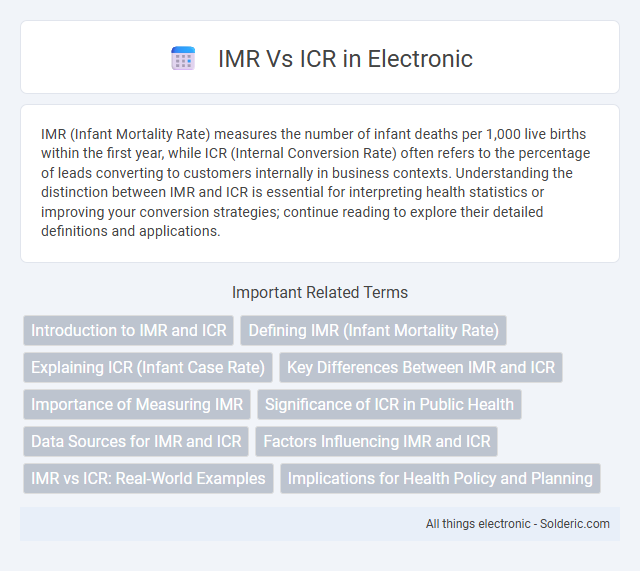IMR (Infant Mortality Rate) measures the number of infant deaths per 1,000 live births within the first year, while ICR (Internal Conversion Rate) often refers to the percentage of leads converting to customers internally in business contexts. Understanding the distinction between IMR and ICR is essential for interpreting health statistics or improving your conversion strategies; continue reading to explore their detailed definitions and applications.
Comparison Table
| Feature | IMR (Incident Management Report) | ICR (Incident Command Report) |
|---|---|---|
| Purpose | Documents and analyzes incident details post-event | Provides command-level updates during an incident |
| Usage | Used for review, accountability, and future prevention | Used for real-time decision making and coordination |
| Content Focus | Incident timeline, causes, outcomes, and recommendations | Current status, resource allocation, and tactical updates |
| Timing | After incident resolution | During incident management |
| Audience | Management, auditors, and stakeholders | Incident commanders and field teams |
Introduction to IMR and ICR
IMR (Infant Mortality Rate) measures the number of infant deaths per 1,000 live births within the first year of life, serving as a key indicator of a country's healthcare quality and living conditions. ICR (Infant Care Rate), although less commonly referenced, refers to the proportion of infants receiving adequate postnatal care services, including immunization and nutrition. Understanding the distinction between IMR and ICR is essential for evaluating public health strategies aimed at reducing infant mortality and improving early childhood care.
Defining IMR (Infant Mortality Rate)
Infant Mortality Rate (IMR) measures the number of deaths of infants under one year old per 1,000 live births within a specific time frame and region. IMR serves as a critical indicator of a population's overall health, reflecting healthcare quality, socioeconomic conditions, and public health effectiveness. This metric differs from the Crude Death Rate (ICR), which accounts for total deaths per 1,000 individuals regardless of age.
Explaining ICR (Infant Case Rate)
Infant Case Rate (ICR) measures the incidence of specific health conditions or diseases among infants within a defined population over a given time frame, typically expressed per 1,000 or 100,000 live births. Unlike Infant Mortality Rate (IMR), which tracks the number of infant deaths, ICR focuses on the occurrence of diagnosed cases, helping public health officials identify patterns, risk factors, and the burden of infant morbidity. Accurate ICR data supports targeted interventions, healthcare resource allocation, and evaluation of preventive programs aimed at reducing infant disease prevalence.
Key Differences Between IMR and ICR
IMR (Instantaneous Manipulation Rate) measures the immediate response speed in system adjustments, whereas ICR (Incremental Change Rate) quantifies the gradual rate of modifications over time. IMR focuses on short-term performance and reaction efficiency, while ICR emphasizes long-term trend analysis and sustained system evolution. Distinguishing IMR from ICR is crucial for optimizing both real-time system control and long-range strategic planning.
Importance of Measuring IMR
Measuring Infant Mortality Rate (IMR) is crucial because it directly reflects the overall health and well-being of a population, serving as a key indicator of healthcare quality, nutrition, and sanitation. Unlike the Infant Case Rate (ICR), which only tracks reported cases of illness, IMR provides comprehensive insight into the effectiveness of maternal and child health programs and highlights socio-economic disparities. Accurate IMR data guides policy-makers and healthcare providers in implementing targeted interventions to reduce preventable infant deaths and improve survival outcomes.
Significance of ICR in Public Health
The Incidence Case Rate (ICR) plays a critical role in public health by quantifying new cases of a disease within a specified population and time frame, enabling the assessment of outbreak dynamics and effectiveness of interventions. Unlike the Incidence Mortality Rate (IMR), which focuses on death occurrences, ICR provides a more immediate measure of disease transmission and risk levels. Monitoring your community's ICR helps public health officials allocate resources efficiently and implement timely preventive strategies.
Data Sources for IMR and ICR
IMR (Infant Mortality Rate) data primarily originate from national vital statistics systems, including birth and death registries, providing comprehensive records of infant deaths. ICR (Infant Cause-specific Mortality Rate) relies on more detailed data sources such as medical death certificates, hospital discharge records, and cause-of-death coding from health information systems to identify specific causes of infant mortality. You can improve health interventions by understanding and comparing the accuracy and granularity of data sources used for IMR and ICR.
Factors Influencing IMR and ICR
Factors influencing Infant Mortality Rate (IMR) include maternal health, access to quality prenatal and postnatal care, socioeconomic conditions, and availability of immunizations. In contrast, Infection Case Rate (ICR) is primarily affected by pathogen transmission dynamics, public health interventions, population density, and environmental factors such as sanitation and hygiene. Your understanding of these determinants can help target effective strategies to reduce IMR and control ICR in vulnerable populations.
IMR vs ICR: Real-World Examples
The infant mortality rate (IMR) and infant cause rate (ICR) represent crucial metrics in public health assessments, with IMR measuring total deaths per 1,000 live births and ICR specifying deaths attributed to particular causes. Real-world examples include country comparisons where the United States has an IMR of approximately 5.6 but a higher ICR for preterm birth complications, while sub-Saharan African nations display IMRs exceeding 50 due to infectious diseases reflected in their ICRs. These statistics enable targeted interventions by highlighting disparities in healthcare quality and underlying mortality factors affecting infant survival globally.
Implications for Health Policy and Planning
IMR (Infant Mortality Rate) and ICR (Infant Case Rate) serve as critical indicators in shaping health policy and planning by highlighting areas requiring targeted interventions. Lower IMR reflects improvements in neonatal care and vaccination programs, guiding resource allocation to maternal and child health services. Your health policy strategies should leverage IMR and ICR data to optimize preventive care and reduce infant morbidity and mortality effectively.
IMR vs ICR Infographic

 solderic.com
solderic.com